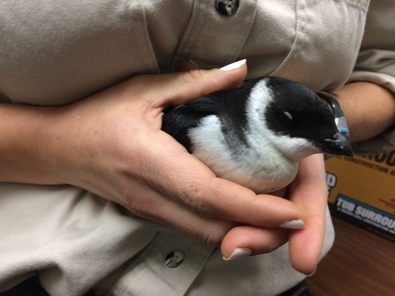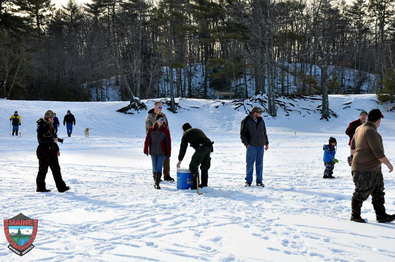Blown Off Course
 Photo Courtesty of Maine Coastal Island NWR
Recently in Region C, we became aware of several dovekies which showed up on land in a period of 48 hours. If you aren’t familiar with what a dovekie is, think about their larger relatives the Atlantic puffin, razorbill, common murre, or black guillemot. They are all members of the family Alcidae and have black and white coloration in a variety of patterns often associated with this group of birds. The dovekie is the smallest of these birds viewable in Maine, weighing in at approximately 160-200g, or somewhere between a baseball and softball. They are only seen intermittently along the coast of Maine, primarily during winter months. Dovekies spend most of the year at sea and come to land only to raise young, which they do in the high arctic. READ MORE
Ice Fishing With The Wounded Heroes Program Of Maine
 On Saturday, January 21, several Maine Game Wardens and their families helped organize an ice fishing event in Standish for the Wounded Heroes Program of Maine. Fifteen Wounded Heroes, veterans and their families attended Saturday’s free event that focused on good food, good laughs and catching a few Maine brook trout. Portland Water District helped facilitate the event as the event took place at their Otter Pond facility on Number 4 Pond in Standish. Sysco Foods also provided the food for the day while game wardens and other Department staff helped prepare hamburgers, hotdogs and coffee. READ MORE
IFW Biologists Track New England Cottontails In The Snow
 Have you seen this rabbit? The New England cottontail is a State Endangered species in Maine, with an estimated population of less than 300. Each winter, biologists from the Maine Department of Inland Fisheries and Wildlife and our conservation partners conduct snow tracking surveys to monitor the sites known to have cottontails, and to search for new occurrences. So, if you’ve spotted a cottontail (see below for a comparison with the much more common snowshoe hare) please let us know so we can survey the site to confirm their presence. Knowing exactly where cottontails occur is critical to our efforts to restore the species, so we’d greatly appreciate any reports. READ MORE
|